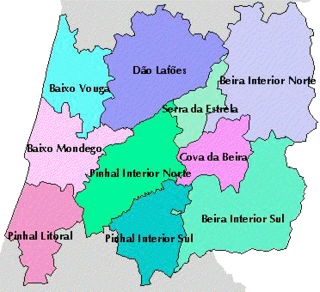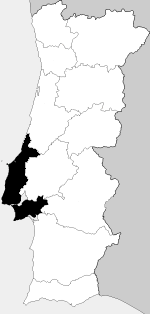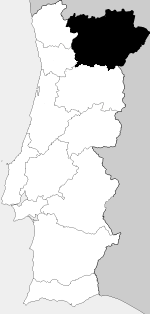
The Algarve is the southernmost NUTS II region of continental Portugal. It has an area of 4,997 km2 (1,929 sq mi) with 451,006 permanent inhabitants, and incorporates 16 municipalities.

Portuguese wine is the result of traditions introduced to the region by ancient civilizations, such as the Phoenicians, Carthaginians, Greeks, and mostly the Romans. Portugal started to export its wines to Rome during the Roman Empire. Modern exports developed with trade to England after the Methuen Treaty in 1703. From this commerce a wide variety of wines started to be grown in Portugal. And, in 1758, one of the first wine-producing regions of the world, the Região Demarcada do Douro was created under the orientation of Marquis of Pombal, in the Douro Valley. Portugal has two wine-producing regions protected by UNESCO as World Heritage: the Douro Valley Wine Region and Pico Island Wine Region. Portugal has a big variety of local kinds, producing a very wide variety of different wines with distinctive personality.

Dão is a Portuguese wine region situated in the Região Demarcada do Dão with the Dão-Lafões sub region of the Centro, Portugal. It is one of the oldest established wine regions in Portugal. Dão wine is produced in a mountainous region with a temperate climate, in the area of the Rio Mondego and Dão rivers in the north central region of Portugal. The region became a Denominação de Origem Controlada (DOC) appellation in 1990. The Dão region is the origin of the Touriga Nacional vine that is the principal component of port wine.

Alentejo is a Portuguese wine region in the Alentejo region. The entire region is entitled to use the Vinho Regional designation Alentejano VR, while some areas are also classified at the higher Denominação de Origem Controlada (DOC) level under the designation Alentejo DOC. VR is similar to the French vin de pays and DOC to the French AOC. In the southern half of Portugal, the Alentejo region covers about a third of the country and is sparsely populated. In 2005, South Oregon University scientist Gregory V. Jones identified Alentejo as the world's most challenged wine region from a climate change perspective. The region is noted for it vast cork production but has in recent years garnered attention for its table wine production. Some producers of this region still do wine in great potteries as in Roman times.

Tourism in Portugal serves millions of international and domestic tourists. Tourists visit to see cities, historic landmarks, enjoy beaches, or religious sites. As of 2019, Portugal had 27 million visitors. The most popular destinations were Lisbon, Porto, Algarve, the Portuguese Riviera, Madeira, Sintra, Óbidos and Fátima. The most popular with internationals were Lisbon, the Algarve and Northern Portugal. National tourists prefer Northern Portugal, followed by Central Portugal and the Algarve.
The denominação de origem controlada is the system of protected designation of origin for fruit, wines, cheeses, butters, and other agricultural products from Portugal.
Cova da Beira is a Portuguese wine region centered on the Cova da Beira region between the Dão and Vinho Verde DOCs in the wider Beiras VR wine region. Cova da Beira was initially a separate Indicação de Proveniencia Regulamentada (IPR) region, but in 2005, it became one of three subregions of the Beira Interior DOC, which has the higher Denominação de Origem Controlada (DOC) status. Its name may still be indicated together with that of Beira Interior, as Beira Interior-Cova da Beira.

Távora-Varosa is a Portuguese wine region located in the northwestern section of the Beiras region. The region is designated as Denominação de Origem Controlada (DOC) after it was promoted from its former Indicação de Proveniencia Regulamentada (IPR) status, when it was called Varosa IPR. At the same time, the former Encostas da Nave IPR, bordering the Douro, was absorbed into the Távora-Varosa DOC.
Lagoa is a Portuguese wine region centered on the Lagoa municipality in the Algarve region. The region has Portugal's highest wine classification as a Denominação de Origem Controlada (DOC). The region is bordered to the west by the Portimão DOC and to the east by Tavira DOC. The region has been historically known for its fortified wine production but has been expanding its table wine production in recent years.
Lagos is a Portuguese wine region centered on the Lagos municipality in the Algarve region. The region has Portugal's highest wine classification as a Denominação de Origem Controlada (DOC). Located on the southwestern corner of Algarve, the region is bordered to the east by the Portimão DOC.
Portimão is a Portuguese wine region centered on the Portimão municipality in the Algarve region. The region has Portugal's highest wine classification as a Denominação de Origem Controlada (DOC). The region is bordered by the Lagoa DOC to the east and the Lagos DOC to the west.
Moscatel de Setúbal is a Portuguese muscatel produced around the Setúbal Municipality on the Península de Setúbal. The region is known primarily for its fortified Muscat wines known as Moscatel de Setúbal. The style was believed to have been invented by José Maria da Fonseca, the founder of José Maria da Fonseca, the oldest table wine company in Portugal dating back to 1834. J.M. Fonseca company still holds a quasi-monopoly control over the production of Moscatel de Setúbal today.
Tavira is a Portuguese wine region centered on the Tavira Municipality in the Algarve region. The region has Portugal's highest wine classification as a Denominação de Origem Controlada (DOC). Extending to the Spanish border, the region is flanked on the west by the Lagoa DOC.
Vidigueira is a Portuguese wine region centered on the Vidigueira municipality in the Alentejo region. The region was initially an Indicação de Proveniencia Regulamentada (IPR) region, then elevated to Denominação de Origem Controlada (DOC) status. In 2003, it became one of eight subregions of the Alentejo DOC. Its name may still be indicated together with that of Alentejo, as Alentejo-Vidigueira.

Beiras is a Portuguese wine region covering the same areas as its namesake region. The region is classified as a Vinho Regional (VR), a designation similar to a French vin de pays region. Located in the northern regions of Portugal, Beiras produces wines of every imaginable style including sparkling and fortified wines, but quality varies dramatically depending on producer and region.

Lisboa, until 2009 named Estremadura, is a Portuguese wine region covering the same areas as the Estremadura region, and taking its name from the country's capital. The region is classified as a Vinho Regional (VR), a designation similar to a French vin de pays region. While the Beiras and Alentejo VRs are largest geographically, the Lisboa region is Portugal's largest producer of wine by volume. The region stretches from Lisbon along the Atlantic coast to the Bairrada DOC.

Tejo, until 2009 named Ribatejo, is a Portuguese wine region covering the same areas as the Ribatejo Province. It takes its name from the river Tejo (Tagus). The entire region is entitled to use the Vinho Regional designation Tejo VR, while some areas are also classified at the higher Denominação de Origem Controlada (DOC) level under the designation DoTejo DOC. VR is similar to the French vin de pays and DOC to the French AOC.

Minho, formerly Rios do Minho, is a Portuguese wine region covering the same areas as the Vinho Verde DOC. The region is classified as a Vinho Regional (VR), a designation similar to a French vin de pays region. The wines of the Minho and Vinho Verde are nearly identical except for the Minho VR allowing foreign grape varieties to be used that are excluded from the Denominação de Origem Controlada (DOC) regulations for Vinho Verde.

Trás-os-Montes is a Portuguese wine region located in the Trás-os-Montes e Alto Douro region. The entire wine region is entitled to use the Vinho Regional designation Transmontano VR, while some areas are also classified at the higher Denominação de Origem Controlada (DOC) level under the designation Trás-os-Montes DOC. VR is similar to the French vin de pays and DOC to the French AOC.











